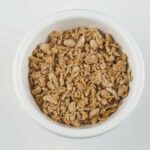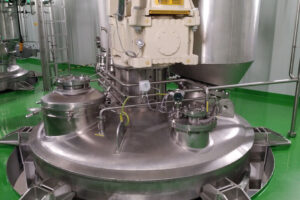Germans are eating less and less meat. According to the latest figures from the Federal Office for Agriculture and Food (BLE), yearly per capita consumption fell below 52 kg for the first time last year. Just five years earlier, that figure was almost 61 kg. The industry is responding to this continuous decline by developing a growing number of plant-based alternatives. However, even if the trend is progressively plant-based, manufacturers should not be fooled, as the majority of consumers still reach for steak, sausage or fish – but, for various reasons, do so less frequently than before.
Hybrid products for reduced meat consumption
So-called hybrid products are designed to appeal to precisely these consumers, containing both animal and plant-based components. Protein sources that are found in vegan and vegetarian alternatives, such as wheat, faba beans or peas, can also be used in hybrid products. When a part of the meat is replaced, the typical meaty texture remains nearly identical or gets even better in terms of juiciness and nutritional profile. If a higher portion of meat or fish is to be replaced, natural texturisers, flavourings and colourings can be used to recreate the familiar taste and mouthfeel. Alternatively, manufacturers can create innovative, standalone hybrid products.
The first wave of hybrid products arrived in German supermarkets as early as 2021. Ingredient manufacturers such as Beneo believe that such products have the potential to become an essential part of the global diet based on strong supporting arguments: They provide the anticipated meat-like texture and juicy mouthfeel with less fat, combining nutritional and sensory benefits. Depending on local raw material prices, it can also offer recipe cost reductions. These hybrid concepts offer an interesting solution, too, next to the plant-based products, for those who do not (yet) identify as vegetarian or vegan.
Hybrid products have a potentially broad target group: Globally, almost 1 in 3 consumers identifies as flexitarian and 4 in 5 consumers have already adopted or are on their way to adopting a meat-reduced lifestyle. These figures come from a global consumer survey conducted on behalf of Beneo which also investigated the specific potential of meat hybrid products, with half of European respondents saying that they were interested in them. At a global level, flexitarians in particular showed the highest purchase intention, with 71% saying they would buy a meat hybrid. Respondents mainly saw the products as a way of reducing meat consumption (49%) or maintaining a sustainable and innovative approach to nutrition (43% each). However, the survey also revealed that some consumers still have concerns about the taste of such products.
Well balanced nutritional profile
As with every food innovation, manufacturers should not just wait for increasing familiarity among shoppers, but create transparency by clearly communicating the products, their origin and, above all, their benefits – directly on-pack. Instead of focusing on the percentage of meat replaced, producers can highlight nutritional benefits of both the meat and the plant-based sources. The nutritional profile of hybrid meats can be well balanced. Plant-based components can add fibre and minerals to the meat and often reduce the fat content and calories of the end product, opening up opportunities to improve its Nutri-Score. However, when a greater amount of meat is being replaced, the protein content of the hybrid product is often lower than the original version. Adding plant-based proteins to the recipe can allow to achieve a similar protein content as the full-meat version. The type and quality of the functional plant-based ingredients is therefore crucial in order to provide a good nutritional profile while keeping the taste and texture close to the original.
Texturates for a juicy result
The Meatless texturates from Beneo are perfect for plant-based alternatives to meat and fish and/or hybrid products. The range includes, for example, flakes made from rice, faba beans and wheat, which are available in various particle sizes and have a high water holding capacity, delivering great juiciness, high heat stability and a clean taste. The Beneo-Technology Center tests vegan, vegetarian and hybrid solutions by developing its own recipes.
Burger patty with 40% less meat
Beneo was able to develop a hybrid, low-fat burger with 40% less meat based on Meatless Faba bean flakes while achieving a firm texture, increased juiciness and fatty mouthfeel. The flakes boost the fibre content and the burger also has lower fat and calorie levels compared to a 100% beef burger. Furthermore, the partial meat replacement can significantly reduce recipe costs depending on local raw material prices. In addition, a Meatless Binder can be used in the recipe to keep the burger mass nicely together during preparation, while also providing a good bite in the final product. When less than 20% of the meat content is replaced, a binder is not needed. Meatless Flakes are easy to incorporate into recipe and production processes and have a great freeze-thaw stability. Beneo has also developed hybrid meatballs and minced meat recipes as well as a hybrid fish burger and is currently working on further developments of partial and fully plant-based recipes.
Cooperation on an equal footing
Consumers that buy hybrid products will benefit both their conscience, their taste experience and their wallet. In addition to an appealing sensory profile, manufacturers should therefore consider cost efficiency from the outset. Close collaboration with ingredient manufacturers during recipe development offers an advantage for those producing end products that will land on supermarket shelves. Hybrid meat products allow manufacturers to satisfy consumer demand for less meat, while hybrid fish options can be a solution to the growing challenge of over-fishing. At the same time, cutting meat or fish in a product is an easy and effective way to reduce its impact on the environment.
Beneo GmbH, Mannheim, Germany











